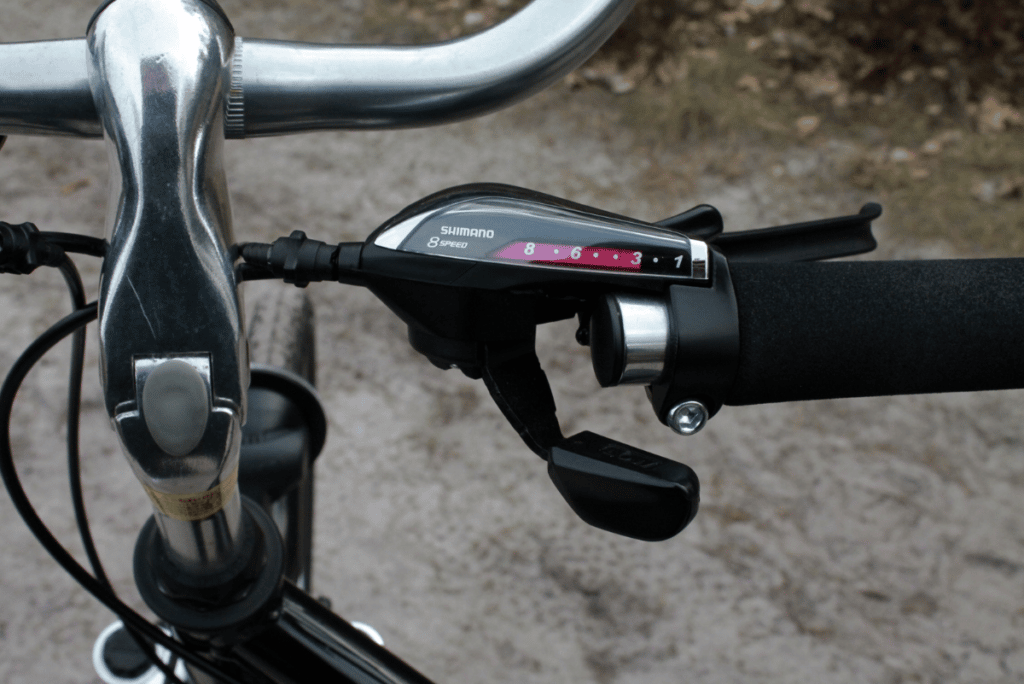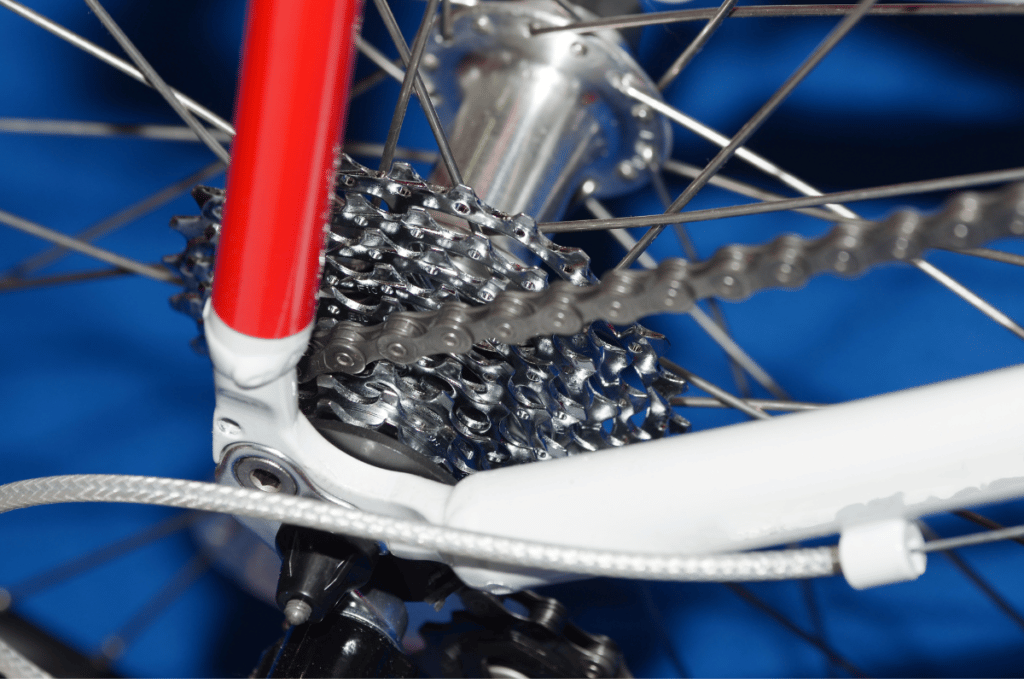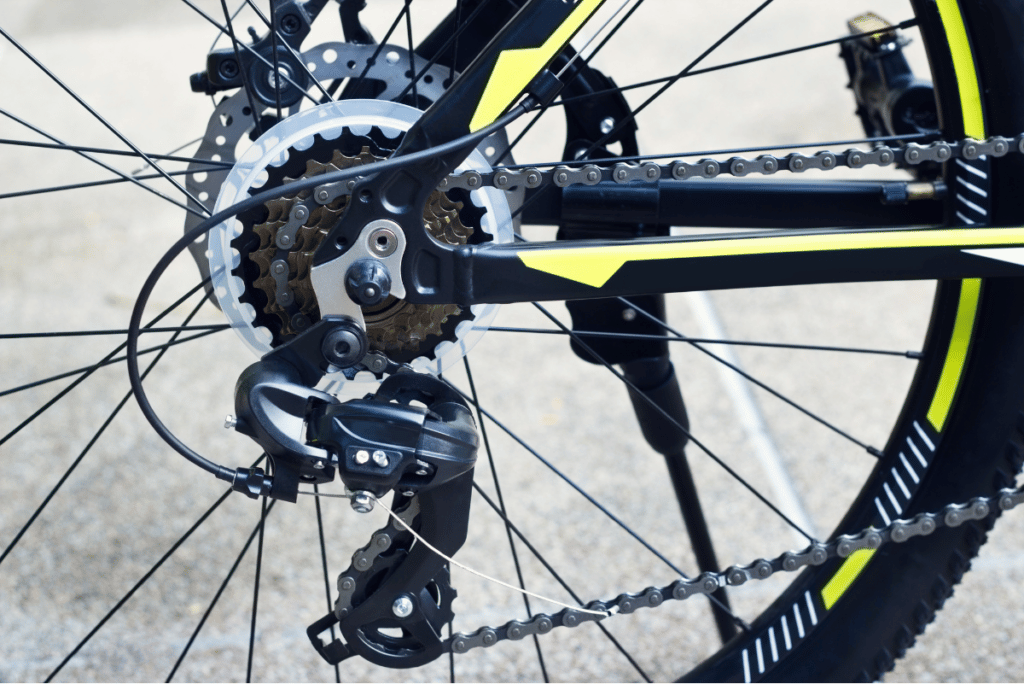Using gears helps you ride a bike efficiently and enjoyably. Gears help to turn the pedals effectively and consistently. The number of gears required are influenced by what you need and want from a ride. Fitness, cargo, pedal assistance, terrains and wind direction all influence the need for gears.
What Do Bike Gears Do?
Gears convert the effort of turning the pedals into a comfortable rhythm at different speeds. Muscle power and riding conditions control the number of turns (or cadence) you can make. More gears change the cadence and help us ride uphill, transport stuff, beat blustery winds, and improve fitness.
Gears run in ranges, from low to high. A low gear is easier to pedal than a high gear from a standing start. As you pick up speed a higher gear is easier to use.
A low gear makes the bike travel less distance for one full turn of the pedals than a higher gear. A lower gear also makes pedalling against any resistance easier than a higher gear.
A higher gear allows you to maintain speed because your cadence is more comfortable when you make fewer pedal rotations over the same distance.
A comfortable and efficient way to pedal is between 80 and 100 revolutions of the pedals per minute. We’ve all seen how wacky and uncontrollable it looks to pedal more vigorously than this and the additional effort and stress below this level is not sustainable. Gears allow you to have more of a say on these revolutions per minute.

A gear selection on a bike is achieved by two cranks in the middle constantly turning a chain around a chainring at the front and one cog from a selection rotating around the rear wheel. You can have more than one chainring at the front and more than one cog at the rear.
More than one chainring creates a chainset at the middle of the bike and a grouping of cogs at the rear is called a cassette. The bike will always be in one gear when the chain is attached to both the chainring and the rear cog.
Chainrings and cogs have teeth which the chain grabs on its way round. The number of teeth on a chainring and cog help to define the gear by way of a ratio. Broken down very simply, depending upon which gear you are in will determine how far the bike can travel for one full revolution of the pedals.
Chainrings on off-the-shelf bikes can run from 28 teeth to 52 teeth typically. Rear cassettes will house cogs running from 9 teeth to around 52 teeth.
How Many Gears Can a Bike Have?
A bike can have one gear and can go up to 30 gears. Bike design and the riding discipline are the biggest influence. The number of gears a bike can have depends on how you want to use it. Compare the effort of a gentle commute on a flat road surface to a muddy climb on the side of a mountain.
Gears make riding more effective but not every bike is designed to do the same thing. Component manufacturers such as Shimano and SRAM have made a micro-industry out of gears. You can have them with wires or without, electronic or manual.
A BMX has one gear and is designed primarily for very short rides at low-speeds performing tricks. Unless you are on a race track, you don’t pedal as often as you might on a commuting bike. You also don’t need the bulk and weight of gearing to get in the way of your acrobatic skills.
Riding a commuting bike usually needs more gears because you might encounter hills, carry shopping, or face alternating wind conditions. All these impact the effort needed to get the bike started and keep your pedalling comfortable. You’ve probably experienced this when turning a street corner in high winds.
If you like to use a bike for more rigorous exercise, you could find yourself needing more gears to climb some steeper hills, or higher gears to allow you to keep a cadence of 80-100 revolutions per minute and you travel faster as your legs get stronger.
Are More Gears Better on a Bike?
More gears will be better on a bike when you can’t pedal at a cadence which is both comfortable and manageable. Some can pedal faster or slower on one gear with practice and never need more than that. But as you face resistance from hills, fitness or weather, more gears help your pedalling rhythm.
If you face a tough oncoming breeze on a single-geared bike, you have to put in more effort to maintain the speed because the wind resistance slows you down. If you had a lower gear to select, you can maintain the cadence and not have to fight the conditions as much. The same principle applies when you approach a hill.
Having 30 gears is not as sporty or game-changing as you might imagine. The more gears you have, the more likely it is that some of the ratios are going to be very similar. Two gears will move the bike forward the same distance as each other. So you might not need to use all of them anyway. I have 20 gear options on my 2013 road bike and for 80% of the time, I use three of these.
Road bikes tend to have between 15 and 24 gears. This range allows for low gears at one extreme to climb steep hills but also enough range to make subtle shifts which really helps for endurance rides. As you tire, you can shift into a lower gear which makes pedalling easier and you might be able to maintain the same speed. You rarely use the highest gears on a road bike, as these are designed for sprinting at top speed.

Do More Gears Make a Bike Go Faster?
More gears along do not equate to more speed. Because the aim of gears is to create the most effective cadence to create the best-engineered pedalling action you can, it might not be necessary to have multiple gears. If you set up the correct ratio, one gear could give you the fastest speed.
The clearest example of this is a bike used in the sport of track cycling. This discipline is the blue riband of speed-seeking events. The top riders making loops around velodromes do so on bikes with only one gear. The bike travels an enormous distance for one pedal stroke and is impractical for daily use but still, one gear only.
On a more practical level you could select from a small gear ratio which gives you enough ‘range’ to use your bike for most conditions but would not need to have anywhere near 30 gears. The key is that the ratio is not too wide to make gear changing clunky and unreliable.
This is one of the factors behind multiple gears. The rear cassette needs the teeth on each sprocket to synchronise and run smoothly, even without lubrication. To achieve this, there must be a similar number of teeth between neighbouring sprockets. If you went from 13 teeth to 20 teeth, you’d grind to a halt as you stop pedalling with a dislodged chain.
Is it Better to Have More or Less Gears on a Bike?
Having more or less gears on a bike is really a personal choice which depends on a number of factors. One gear is fine for short commutes in town, 26 might be ideal for a day in the mountains. The more gears you have, the more you can vary cadence and speed.
Then there are other factors such as maintenance, road surfaces, hills you might want to climb in your area, weight saving, how you use your bike and how much exploring you want to do.
It’s worth remembering that on a flat piece of road, with no favourable weather conditions, you’ll only be able to ride at one given maximum speed with one gear and maintaining that speed will place an excess load on your joints and muscles. One more ‘higher’ gear and you preserve energy and can reach a slightly higher speed.

3-Speed vs 7-Speed vs 21-Speed
There is a symmetry to these gear ranges and they offer a fine introduction to riding with gears. Gears on bicycles are traditionally changed via cables and a derailleur at the rear wheel which stems from the French word for moving railway lines to allow trains to travel in different directions on the same line and in the same direction.
Is 3 Gears on a Bike Enough?
Modern urban bicycles – like municipal hire bikes used in cities – have three gears but no derailleur. Instead the gears are housed inside the hub of the rear wheel. They operate by the same principle as traditional gears by using toothed wheels. But they are much easier to live with and maintain.
Hundreds and thousands of urban bike riders get by every day with just three gears, when they cannot or do not want or need to reach a breakneck speed. They are perfectly fine for everyday use in and around relatively flat areas.
Is a 7-Speed Bike Enough for Hills?
A 7-speed bike can be the answer to riding uphill. To find a tempo and a cadence to keep the pedals spinning as close to the efficiency of 80-100rpm and not stop. On a flyover or low range mountain trail, a seven speed bike allows you to shift to higher gears even as you ride to find your rhythm.
Why Do You Need 21 Gears on a Bike?
21-speeds moves you into more athletic and training pursuits, with the widest possible range of surfaces, distances and conditions at your disposal. But – all these gears do is change your cadence to make your pedal stroke most efficient for these given changes.
How Many Gears Do You Really Need on a Bike?
You need as many gears as possible to hit a cadence of at least 80 pedal revolutions per minute. This is considered an efficient pedal stroke. You could do this with one gear at a constant speed on a flat road at a constant. As resistance increases, you’ll need more gears to maintain this cadence.
There are millions of single-speed bikes on the world’s roads. These machines are designed as effective modes of transport for workers, vicars, students, commuters and will suit anyone who doesn’t want to sweat during or after a ride.
If you want fitness, crave adventure, or want to be out in the wilderness all day, then more gears will help you overcome all of the natural and man-made forms of resistance which will impact on that cadence and therefore put more strain on your body.
So you should try more gears if you yearn for that adventure. But remember, you can have all the gears but no ideas…
The post How Many Bike Gears Do I Need? [ANALYSIS] appeared first on Discerning Cyclist.
![How Many Bike Gears Do I Need? [ANALYSIS]](http://bicycle.org/wp-content/uploads/2022/11/2-5-1024x684-1-760x508.png)